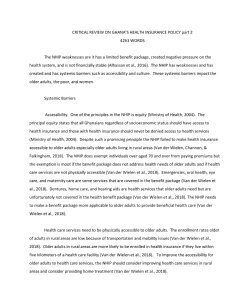CRITICAL REVIEW ON GHANA’S HEALTH INSURANCE POLICY The NHIP weaknesses are it has a limited benefit package, created negative pressure on the health system, and is not financially st part 24263 WORDS
CRITICAL REVIEW ON GHANA’S HEALTH INSURANCE POLICY The NHIP weaknesses are it has a limited benefit package, created negative pressure on the health system, and is not financially st part 24263 WORDS
CRITICAL REVIEW ON GHANA’S HEALTH INSURANCE POLICY part 2
4263 WORDS
The NHIP weaknesses are it has a limited benefit package, created negative pressure on the health system, and is not financially stable (Alhassan et al., 2016). The NHIP has weaknesses and has created and has systemic barriers such as accessibility and culture. These systemic barriers impact the older adults, the poor, and women.
Systemic Barriers
Accessibility. One of the principles in the NHIP is equity (Ministry of Health, 2004). The principal equity states that all Ghanaians regardless of socioeconomic status should have access to health insurance and those with health insurance should never be denied access to health services (Ministry of Health, 2004). Despite such a promising principle the NHIP failed to make health insurance accessible to older adults especially older adults living in rural areas (Van der Wielen, Channon, & Falkingham, 2018). The NHIP does exempt individuals over aged 70 and over from paying premiums but the exemption is moot if the benefit package does not address health needs of older adults and if health care services are not physically accessible (Van der Wielen et al., 2018). Emergencies, oral health, eye care, and maternity care are some services that are covered in the benefit package (Van der Wielen et al., 2018). Dentures, home care, and hearing aids are health services that older adults need but are unfortunately not covered in the health benefit package (Van der Wielen et al., 2018). The NHIP needs to make a benefit package more applicable to older adults to provide beneficial health care (Van der Wielen et al., 2018).
Health care services need to be physically accessible to older adults. The enrollment rates older of adults in rural areas are low because of transportation and mobility issues (Van der Wielen et al., 2018). Older adults in rural areas are more likely to be enrolled in health insurance if they live within five kilometers of a health care facility (Van der Wielen et al., 2018). To improve the accessibility for older adults to health care services, the NHIP should consider improving health care services in rural areas and consider providing home treatment (Van der Wielen et al., 2018).
